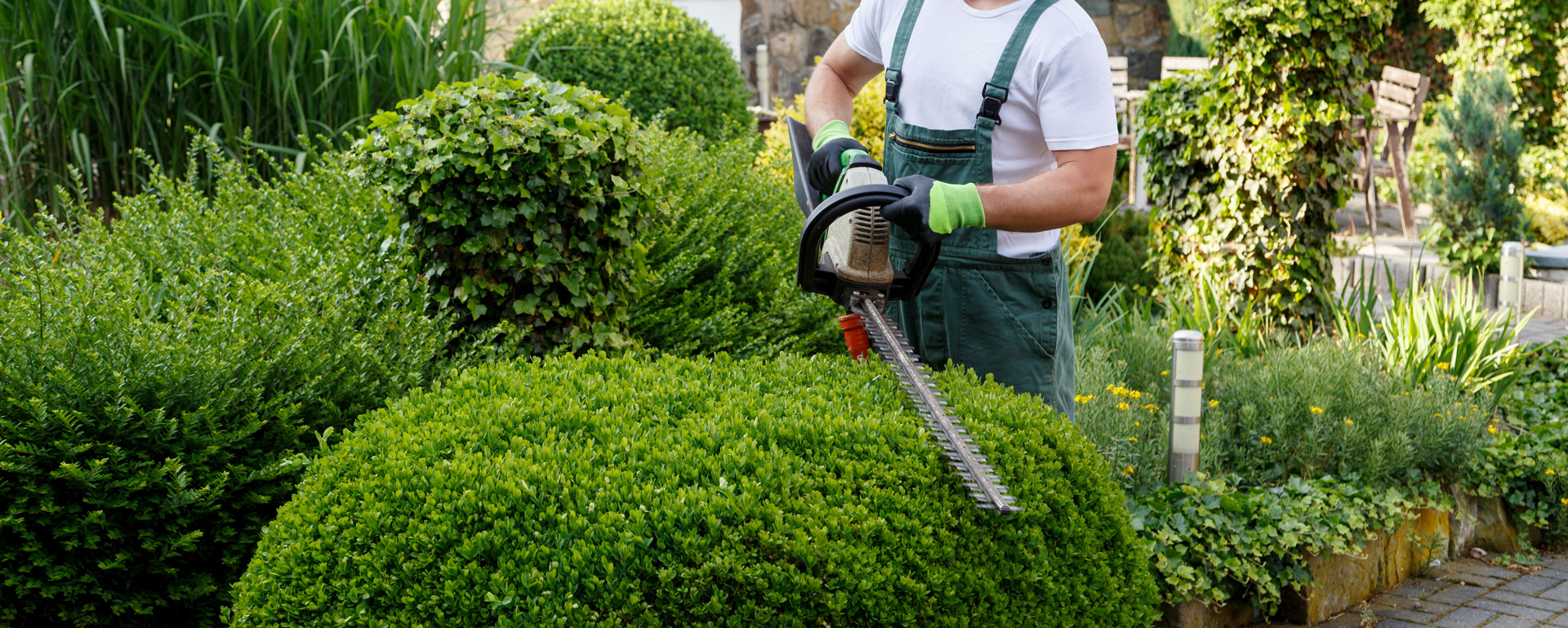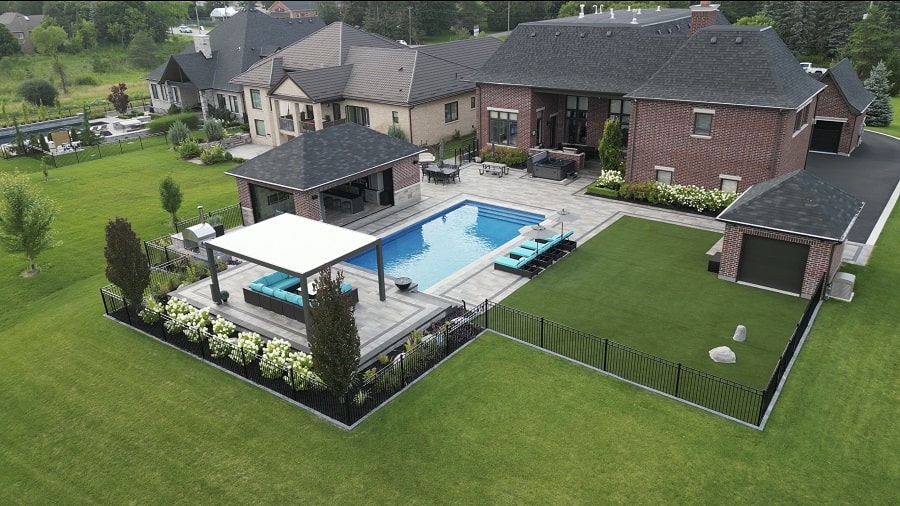Understanding the Comprehensive Extent of Functions in Professional Landscape Design Services
The considerable range of professional landscape design services includes a range of fundamental elements - landscaping. It consists of landscape style principles, plant option, and hardscaping attributes. Furthermore, it deals with watering systems and upkeep techniques. Each aspect plays an important role in developing practical and aesthetically pleasing exterior areas. Comprehending just how these elements collaborate can disclose much regarding the art and scientific research of landscaping. The journey into this detailed field is simply beginning.
Landscape Style Principles
Efficient landscape layout concepts are essential for producing unified exterior rooms that boost both visual allure and performance (Learn More). These concepts assist the plan of components within the landscape, ensuring a cohesive visual experience. Key components include balance, which distributes aesthetic weight equally; percentage, which relates the size of various elements per various other and the room; and unity, which develops a sense of wholeness through regular motifs and products

Plant Option and Installation
In the domain name of professional landscape design, plant selection and installment play a vital role in attaining a prospering garden. Stressing native plant benefits, seasonal considerations, and the details soil and sunshine demands of each species ensures a lasting and visually pleasing landscape. Mindful planning in these locations not just enhances biodiversity yet likewise advertises long-lasting eco-friendly health.
Native Plant Benefits
Why should property owners take into consideration native plants for their landscape design projects? Native plants supply various advantages that enhance both looks and environmental sustainability. They are well-adapted to regional environments, needing less water and upkeep compared to non-native types. This strength reduces the requirement for chemical plant foods and pesticides, promoting a much healthier ecosystem. In addition, native plants offer environment and food for local wild animals, consisting of pollinators, which can increase biodiversity in houses. Their knowledge with neighborhood dirt and weather likewise causes far better growth rates and longevity. By selecting native plants, house owners not just develop visually enticing landscapes yet also add to environmental preservation, making a favorable effect on their local environment. As a result, indigenous plants stand for a clever selection for landscape design tasks.
Seasonal Plant Considerations
Homeowners who have embraced indigenous plants in their landscaping can further enhance their outdoor spaces by considering seasonal plant selections. By integrating plants that thrive in specific seasons, they can develop vibrant and visually attractive landscapes throughout the year. Spring may usher in lively blossoms like tulips and daffodils, while summer season can display rich foliage and colorful perennials. Fall presents a combination of warm tones with asters and goldenrods, while winter months can be emphasized with evergreens and ornamental grasses for texture. Specialist landscaping companies usually advise choosing plants that not only enhance existing indigenous species but likewise offer year-round interest and assistance regional wild animals. This thoughtful method to seasonal plant option guarantees a constantly developing and sustainable garden environment.
Dirt and Sunlight Requirements
Successful landscape design rests on recognizing the particular soil and sunlight demands of plants. Different species grow under varying conditions, requiring a mindful analysis of both aspects during the option process. Dirt types, such as sandy, clay, or fertile, influence drainage, nutrient accessibility, and root growth. Additionally, pH degrees can influence plant health and wellness, requiring soil screening to determine suitability. Sunlight needs differ substantially; some plants prosper in complete sun, while others favor complete or partial color. An expert landscaping company thinks about these components to guarantee peak development and visual appeal. By lining up plant selections with the environment's particular features, landscapes can achieve sustainability, durability, and aesthetic consistency, inevitably resulting in effective plant facility and lasting maintenance.
Hardscaping Features and Construction

While landscaping typically stimulates pictures of lush greenery and vibrant blossoms, hardscaping features play a vital role in defining outside areas. These components, which consist of outdoor patios, sidewalks, retaining walls, and attractive stonework, supply framework and performance to yards and backyards. Hardscaping makes use of materials such as concrete, timber, stone, and block, enabling varied designs that complement the natural landscape.
The building of hardscaping functions needs cautious planning and implementation to ensure longevity and visual appeal. Professionals analyze site conditions, water drainage, and spatial connections to create natural outdoor settings. Appropriate installation strategies are vital, as they avoid issues like disintegration and shifting over time.
Including hardscaping not just boosts the aesthetic rate of interest of a residential property however also promotes outside activities, making it a fundamental aspect of detailed landscaping services. Inevitably, thoughtful hardscaping adds to both the performance and charm of exterior spaces.
Irrigation Solutions and Water Monitoring
Efficient irrigation systems and water management are essential components of professional landscaping, as they ensure that plants obtain the needed hydration for ideal growth. These systems can differ from simple drip irrigation arrangements to sophisticated computerized automatic sprinkler, created to fulfill the details needs of varied landscapes. Proper water monitoring not only maximizes water use, minimizing waste, however additionally improves plant health and reduces condition threats.
Landscaping experts examine various variables, including soil type, plant varieties, and regional environment, to establish customized watering remedies. Furthermore, including rain harvesting techniques can even more boost sustainability and efficiency. Regular maintenance of irrigation systems is necessary to preserve functionality and protect against leakages, which can bring about water loss and raised costs (Learn More). Inevitably, a properly designed watering system plays a crucial function in preserving the aesthetic charm of outside areas while promoting eco-friendly stewardship within professional landscape design techniques
Yard Care and Maintenance Methods
Grass treatment and upkeep approaches are essential for achieving a rich, healthy lawn that improves the total landscape. These strategies incorporate various techniques targeted at promoting suitable growth and aesthetic charm. Normal mowing is vital, as it urges thick, even development while stopping weeds from developing. Furthermore, correct fertilizing offers needed nutrients, with applications tailored to the certain yard type and soil problems.
Watering techniques should concentrate on deep, seldom watering to urge root development, while oygenation boosts soil framework and advertises nutrition absorption. Parasite and disease administration is additionally important; recognizing issues early permits reliable treatments that reduce damages.
Ultimately, overseeding can revitalize broken my blog or thin yards, boosting thickness and color. By applying these targeted lawn care methods, landscape design specialists can guarantee that lawns continue to be vivid and healthy and balanced throughout the seasons, substantially adding to the overall charm of the residential property
Seasonal Landscape Treatment and Maintenance
As the periods modification, appropriate landscape care becomes important for maintaining the wellness and beauty of exterior spaces. Each period presents special challenges and demands. In spring, landscape experts concentrate on pruning, planting, and feeding to encourage development. Summer season demands routine watering, weed control, and pest administration to shield newly developed plants.

Throughout the year, seasonal landscape maintenance assurances that outside locations continue to be healthy and visually enticing. Expert services can supply customized upkeep strategies that adapt to the specific demands of each season, permitting homeowner to appreciate dynamic landscapes year-round. Overall, seasonal treatment is a vital element of specialist landscaping that promotes long life and aesthetic value.

Sustainable Landscaping Practices
An expanding number of residential property owners are embracing sustainable landscaping practices to create eco-friendly outdoor spaces. These methods concentrate on saving sources, improving biodiversity, and lessening ecological effect. Native plants are typically chosen for their low tide requirements and compatibility with local environments, lowering the demand for chemical plant foods and pesticides. Rain gardens and absorptive paving are used to take care of stormwater overflow, promoting groundwater recharge and decreasing disintegration.
Lasting landscape design integrates organic gardening techniques that prioritize dirt health and advertise all-natural insect control. Efficient irrigation systems, such as drip watering and rainwater harvesting, help optimize water use. Furthermore, landscape developers significantly support for the usage of recycled products, such as recovered wood and rocks, to lessen waste. By embracing these lasting techniques, homeowner not only contribute to ecological preservation yet likewise create aesthetically pleasing environments that can love minimal maintenance.
Regularly Asked Inquiries
Just how Long Does a Landscape Design Project Typically Take to Full?
Commonly, a landscaping task can take anywhere from a few days to several weeks to complete, relying on the task's style, complexity, and size needs. Elements such as climate and resource accessibility likewise affect timelines.
What Variables Impact the Cost of Landscaping Services?
Various variables influence landscaping solution costs, consisting of project dimension, layout complexity, material high quality, labor expenses, geographic location, and seasonal need. Each element contributes distinctively to the total financial needs of a landscape design task.
Are Landscaping Services Available Year-Round?
Landscaping services are generally available year-round, although availability might vary based on area, seasonal weather, and particular service offerings. Some services might be restricted during extreme climate or off-peak seasons.
Do Landscaping Companies Offer Warranties on Their Work?
Several landscaping companies do use guarantees on their work, which can vary in size and insurance coverage. Clients are encouraged to ask about specific terms, guaranteeing they comprehend what is guaranteed and any conditions that apply.
Can I Design My Landscape Without Professional Assist?
Yes, people can make their landscapes without specialist aid. They might lack know-how in plant option, format, and ecological factors to consider, possibly leading to less effective designs that can require pricey adjustments later on.
In the domain of specialist landscaping, plant option and setup play an essential function in accomplishing a prospering yard. Home owners that have accepted native plants in their landscaping can additionally enhance their exterior rooms by considering seasonal plant options. Successful landscape design pivots on comprehending the details soil and sunshine requirements of plants. Effective irrigation systems and water administration are vital elements of professional landscape design, as they ensure that plants receive the necessary hydration for suitable growth. Landscaping specialists assess different variables, including soil type, plant types, and neighborhood climate, to create tailored watering services.